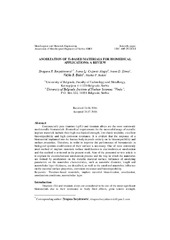Anodization of Ti-based materials for biomedical applications: A review
Апстракт
Commercially pure titanium (cpTi) and titanium alloys are the most commonly used metallic biomaterials. Biomedical requirements for the successful usage of metallic implant materials include their high mechanical strength, low elastic modulus, excellent biocompatibility and high corrosion resistance. It is evident that the response of a biomaterial implanted into the human body depends entirely on its biocompatibility and surface properties. Therefore, in order to improve the performance of biomaterials in biological systems modification of their surface is necessary. One of most commonly used method of implant materials surface modification is electrochemical anodization and this method is reviewed in the present work. Aim of the presented review article is to explain the electrochemical anodization process and the way in which the nanotubes are formed by anodization on the metallic material surface. Influence of anodizing parameters on the nanotubes characteristics, such as nanotube ...diameter, length and nanotubular layer thickness, are described, as well as the anodized nanotubes influence on the material surface properties, corrosion resistance and biocompatibility.
Кључне речи:
Titanium-based materials / implant material bioactivation / anodization / anodization conditions / nanotubular layerИзвор:
Metallurgical & Materials Engineering, 2016, 22, 3, 121-143Издавач:
- Association of Metallurgical Engineers of Serbia
Финансирање / пројекти:
- Микромеханички критеријуми оштећења и лома (RS-MESTD-Basic Research (BR or ON)-174004)
Колекције
Институција/група
Tehnološko-metalurški fakultetTY - JOUR AU - Barjaktarević, Dragana AU - Cvijović-Alagić, Ivana AU - Dimić, Ivana AU - Đokić, Veljko AU - Rakin, Marko PY - 2016 UR - http://TechnoRep.tmf.bg.ac.rs/handle/123456789/3197 AB - Commercially pure titanium (cpTi) and titanium alloys are the most commonly used metallic biomaterials. Biomedical requirements for the successful usage of metallic implant materials include their high mechanical strength, low elastic modulus, excellent biocompatibility and high corrosion resistance. It is evident that the response of a biomaterial implanted into the human body depends entirely on its biocompatibility and surface properties. Therefore, in order to improve the performance of biomaterials in biological systems modification of their surface is necessary. One of most commonly used method of implant materials surface modification is electrochemical anodization and this method is reviewed in the present work. Aim of the presented review article is to explain the electrochemical anodization process and the way in which the nanotubes are formed by anodization on the metallic material surface. Influence of anodizing parameters on the nanotubes characteristics, such as nanotube diameter, length and nanotubular layer thickness, are described, as well as the anodized nanotubes influence on the material surface properties, corrosion resistance and biocompatibility. PB - Association of Metallurgical Engineers of Serbia T2 - Metallurgical & Materials Engineering T1 - Anodization of Ti-based materials for biomedical applications: A review EP - 143 IS - 3 SP - 121 VL - 22 UR - https://hdl.handle.net/21.15107/rcub_vinar_1709 ER -
@article{
author = "Barjaktarević, Dragana and Cvijović-Alagić, Ivana and Dimić, Ivana and Đokić, Veljko and Rakin, Marko",
year = "2016",
abstract = "Commercially pure titanium (cpTi) and titanium alloys are the most commonly used metallic biomaterials. Biomedical requirements for the successful usage of metallic implant materials include their high mechanical strength, low elastic modulus, excellent biocompatibility and high corrosion resistance. It is evident that the response of a biomaterial implanted into the human body depends entirely on its biocompatibility and surface properties. Therefore, in order to improve the performance of biomaterials in biological systems modification of their surface is necessary. One of most commonly used method of implant materials surface modification is electrochemical anodization and this method is reviewed in the present work. Aim of the presented review article is to explain the electrochemical anodization process and the way in which the nanotubes are formed by anodization on the metallic material surface. Influence of anodizing parameters on the nanotubes characteristics, such as nanotube diameter, length and nanotubular layer thickness, are described, as well as the anodized nanotubes influence on the material surface properties, corrosion resistance and biocompatibility.",
publisher = "Association of Metallurgical Engineers of Serbia",
journal = "Metallurgical & Materials Engineering",
title = "Anodization of Ti-based materials for biomedical applications: A review",
pages = "143-121",
number = "3",
volume = "22",
url = "https://hdl.handle.net/21.15107/rcub_vinar_1709"
}
Barjaktarević, D., Cvijović-Alagić, I., Dimić, I., Đokić, V.,& Rakin, M.. (2016). Anodization of Ti-based materials for biomedical applications: A review. in Metallurgical & Materials Engineering Association of Metallurgical Engineers of Serbia., 22(3), 121-143. https://hdl.handle.net/21.15107/rcub_vinar_1709
Barjaktarević D, Cvijović-Alagić I, Dimić I, Đokić V, Rakin M. Anodization of Ti-based materials for biomedical applications: A review. in Metallurgical & Materials Engineering. 2016;22(3):121-143. https://hdl.handle.net/21.15107/rcub_vinar_1709 .
Barjaktarević, Dragana, Cvijović-Alagić, Ivana, Dimić, Ivana, Đokić, Veljko, Rakin, Marko, "Anodization of Ti-based materials for biomedical applications: A review" in Metallurgical & Materials Engineering, 22, no. 3 (2016):121-143, https://hdl.handle.net/21.15107/rcub_vinar_1709 .



